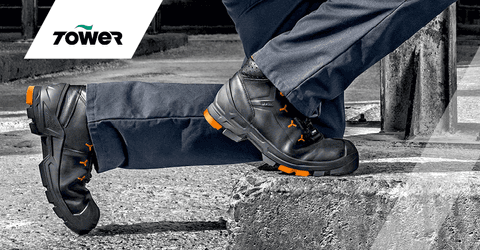
The 2011 footwear safety standards have been in place for more than 10 years. But now new standards are in effect that change safety footwear requirements and the testing methods used.
We believe any improvements to standards that help people work safer and better is positive.
And this important set of new changes will help ensure that people working in hazardous conditions have the best chance of being protected by the safety footwear they are using.
Here’s a rundown of some of the key changes that might affect you and your business.

Slip resistance markings
The previous SRA, SRB, and SRC markings will no longer exist. This is because slip resistance is an important universal feature and is now mandatory. Therefore, it no longer needs the marking.
There is however still the option for manufacturers to carry out an additional slip test. If passed, this will mean that their footwear can carry a new SR symbol.
Slip resistance testing
This will no longer feature a steel surface. Instead, all slip resistance testing will be carried out on a ceramic tile surface. But the contaminant solution used for the optional SR tests will be different.
There will also be an important change to the area of the footwear being tested. Instead of the flat of the footwear, it will now be tested on the heel and the forepart.
Water resistant symbols
The old WRU (water-resistant uppers) symbol will be replaced by a new WPA (water penetration and absorption) code. It will be the same test, but with some change to shoe position and use of paper.
Scuff cap abrasion resistance
This is a new requirement that will test the durability of scuff caps over 1,000 abrasion cycles, to ensure it can protect the toe cap. If successful, it will then carry a SC symbol.
Ladder grip test
The standard for ladder grip testing has now been raised to match firefighter standard. When successful, the footwear will carry the symbol LG.
Puncture resistance
There will now be two test methods for NMAPI (non-metal anti-penetration inserts), one featuring a 4.5mm nail (carrying the symbol PL), and one with a 3mm nail (carrying the symbol PS).
This new standard will be important to understand for anyone working around perforation risks such as sewing needles in factories, or hypodermic needles in surgical environments.
Ankle protection test
The previous point of impact testing method was used on boots of any size. The new requirement will change the area of impact depending on the boot size, for more accurate results.
The new standards have already been published so are in effect right now. The new testing standards will be met for all products. That means new products will always carry the new codes.
The important thing to know is any products certified to the old 2011 standard will not need to be retested. They are still ‘good’ until the certification is due for renewal in five years’ time.
There is no official end date for the old standards, so will likely run alongside the new standards for a few years until the old codes and requirements are officially revoked.

This will depend on your role within the business. We’re a safety distributor, so our responsibility is to stay up to speed on all the changes, to support customers in selecting the most suitable footwear.
If you are RESPONSIBLE FOR FOOTWEAR within your company, then knowing the changes in standards will be vital for specifying and requesting safety footwear from any suppliers.
This is because you’ll need to be specific about the level of protection you require and be able to identify inaccuracies in procurement product requests. Our experts can guide you through this.
If you BUY YOUR OWN FOOTWEAR, then knowing the new code changes will be vital to be able to check the level of protection. Especially as there have been big changes to historic safety markings.
Speak to us. We will help you understand the changes and make sure your current safetywear is still the most suitable protection for anyone working in hazardous environments.
We will talk through your requirements and even help identity the hazards within your work environment. Just fill out our contact form or call us directly on 01202 718000.